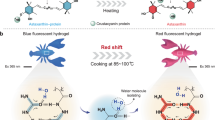Abstract
The combination of efficient light emission and high charge-carrier mobility has thus far proved elusive for polymer semiconductors, with high mobility typically achieved by cofacial π-electron system to π-electron system interactions that quench exciton luminescence1,2. We report a new strategy, comprising the introduction of a limited number of more effective hopping sites between otherwise relatively isolated, and thus highly luminescent, polyfluorene chains. Our approach results in polymer films with large mobility (μ≈3–6×10−2 cm2 V−1 s−1) and simultaneously excellent light-emission characteristics. These materials are expected to be of interest for light-emitting transistors3, light-emitting diode sources for optical communications4 and may offer renewed hope for electrically pumped laser action2,5,6. In the last context, optically pumped distributed feedback lasers comprising one-dimensional etched silica grating structures coated with polymer have state-of-the-art excitation thresholds (as low as 30 W cm−2 (0.1 nJ per pulse or 0.3 μJ cm−2) for 10 Hz, 12 ns, 390 nm excitation) and slope efficiencies (up to 11%).
This is a preview of subscription content, access via your institution
Access options
Subscribe to this journal
Receive 12 print issues and online access
$259.00 per year
only $21.58 per issue
Buy this article
- Purchase on Springer Link
- Instant access to full article PDF
Prices may be subject to local taxes which are calculated during checkout



Similar content being viewed by others
References
Swager, T. Polymer light-emitting devices—Light from insulated organic wires. Nature Mater. 1, 151–152 (2002).
Samuel, I. D. W. & Turnbull, G. A. Organic semiconductor lasers. Chem. Rev. 107, 1272–1295 (2007).
Swensen, J. S., Soci, C. & Heeger, A. J. Light emission from an ambipolar semiconducting polymer field-effect transistor. Appl. Phys. Lett. 87, 253511–253513 (2005).
Barlow, I. A., Kreouzis, T. & Lidzey, D. G. A polymer light-emitting diode as an optical communication light source. Organic Electron. 8, 621–624 (2007).
Tessler, N. Lasers based on semiconducting organic materials. Adv. Mater. 11, 363–370 (1999).
Kozlov, V. & Forrest, S. Lasing action in organic semiconductor thin films. Curr. Opin. Solid State Mater. Sci. 4, 203–208 (1999).
Sirringhaus, H. et al. Two-dimensional charge transport in self-organized, high-mobility conjugated polymers. Nature 401, 685–688 (1999).
McCulloch, I. et al. Liquid-crystalline semiconducting polymers with high charge-carrier mobility. Nature Mater. 5, 328–333 (2006).
Perepichka, I. et al. Light-emitting polythiophenes. Adv. Mater. 17, 2281–2305 (2005).
Redecker, M. et al. Nondispersive hole transport in an electroluminescent polyfluorene. Appl. Phys. Lett. 73, 1565–1567 (1998).
Campbell, A. J. et al. Dispersive electron transport in an electroluminescent polyfluorene copolymer measured by the current integration time-of-flight method. Appl. Phys. Lett. 79, 2133–2135 (2001).
Zaumseil, J. & Sirringhaus, H. Electron and ambipolar transport in organic field-effect transistors. Chem. Rev. 107, 1296–1323 (2007).
Hide, F. et al. Semiconducting polymers: A new class of solid-state laser materials. Science 273, 1833–1836 (1996).
Xia, R. et al. Fluorene-based conjugated polymer optical gain media. Organic Electron. 4, 165 (2003).
O’Brien, D. et al. Efficient multilayer electroluminescence devices with poly(m-phenylenevinylene-co-2,5-dioctyloxy-p-phenylenevinylene) as the emissive layer. J. Appl. Phys. 82, 2662 (1997).
Virgili, T. et al. Ultrafast resonant optical switching in isolated polyfluorenes chains. Appl. Phys. Lett. 86, 091113–091115 (2005).
Babel, A. & Jenekhe, S. A. Charge carrier mobility in blends of poly(9,9-dioctylfluorene) and poly(3-hexylthiophene). Macromolecules 36, 7759–7764 (2003).
Tanaka, H. et al. Photopumped laser oscillation and charge carrier mobility of composite films based on poly(3-hexylthiophene)s with different stereoregularity. Japan. J. Appl. Phys. 45, L1077 (2006).
Redecker, M. et al. Mobility enhancement through homogeneous nematic alignment of a liquid-crystalline polyfluorene. Appl. Phys. Lett. 74, 1400–1402 (1999).
Grozema, F. C. et al. Electrodeless measurement of the in-plane anisotropy in the photoconductivity of an aligned polyfluorene film. Adv. Mater. 13, 1627–1630 (2001).
Grell, M. et al. Interplay of physical structure and photophysics for a liquid crystalline polyfluorene. Macromolecules 32, 5810–5817 (1999).
Campoy-Quiles, M. et al. Ellipsometric characterization of the optical constants of polyfluorene gain media. Adv. Funct. Mater. 15, 925–933 (2005).
Sims, M. et al. On the use of optical probes to monitor the thermal transitions in spin-coated poly(9,9-dioctylfluorene) films. J. Phys. Condens. Matter 17, 6307–6318 (2005).
Yasuda, T. et al. Carrier transport properties of monodisperse glassy-nematic oligofluorenes in organic field-effect transistors. Chem. Mater. 17, 264–268 (2005).
Heliotis, G. et al. Emission characteristics and performance comparison of polyfluorene lasers with one- and two-dimensional distributed feedback. Adv. Funct. Mater. 14, 91–97 (2004).
Xia, R. et al. Characterization of a high-thermal-stability spiroanthracenefluorene-based blue-light-emitting polymer optical gain medium. J. Appl. Phys. 98, 083101 (2005).
Heliotis, G. et al. Low-threshold lasers based on a high-mobility semiconducting polymer. Appl. Phys. Lett. 88, 081104–081106 (2006).
Karnutsch, C. et al. Low threshold blue conjugated polymer lasers with first- and second-order distributed feedback. Appl. Phys. Lett. 89, 201108–201110 (2006).
Karnutsch, C. et al. Improved organic semiconductor lasers based on a mixed-order distributed feedback resonator design. Appl. Phys. Lett. 90, 131104–131106 (2007).
Wilkinson, C. I. et al. Enhanced performance of pulse driven small area polyfluorene light emitting diodes. Appl. Phys. Lett. 79, 171–173 (2001).
Acknowledgements
We thank T. Ohnishi and T. Yamada and the Sumitomo Chemical Co. for providing the polymers used in this study and for funding a PhD studentship for B.K.Y. We also thank the EPSRC (Ultrafast Photonics Collaboration Interdisciplinary Research Collaboration (GR/R55078) and Advanced Fellowship to P.N.S. (EP/C539494)) and the Commission of the European Community (FP6-IST-026365 POLYCOM) for financial support.
Author information
Authors and Affiliations
Corresponding author
Supplementary information
Rights and permissions
About this article
Cite this article
Yap, B., Xia, R., Campoy-Quiles, M. et al. Simultaneous optimization of charge-carrier mobility and optical gain in semiconducting polymer films. Nature Mater 7, 376–380 (2008). https://doi.org/10.1038/nmat2165
Received:
Accepted:
Published:
Issue Date:
DOI: https://doi.org/10.1038/nmat2165
This article is cited by
-
Photo-thermo-induced room-temperature phosphorescence through solid-state molecular motion
Nature Communications (2022)
-
Nonlinear meta-optics towards applications
PhotoniX (2021)
-
Distributed feedback organic lasing in photonic crystals
Frontiers of Optoelectronics (2020)
-
Gigantic electric-field-induced second harmonic generation from an organic conjugated polymer enhanced by a band-edge effect
Light: Science & Applications (2019)
-
Short contacts between chains enhancing luminescence quantum yields and carrier mobilities in conjugated copolymers
Nature Communications (2019)



